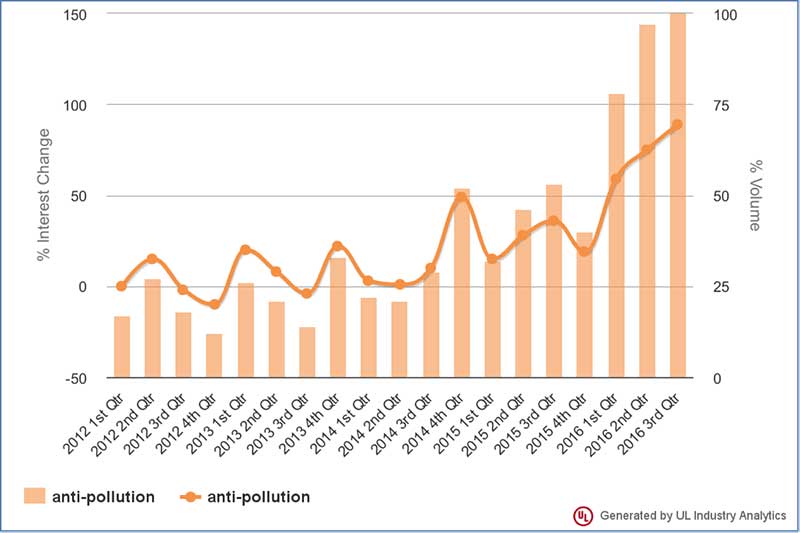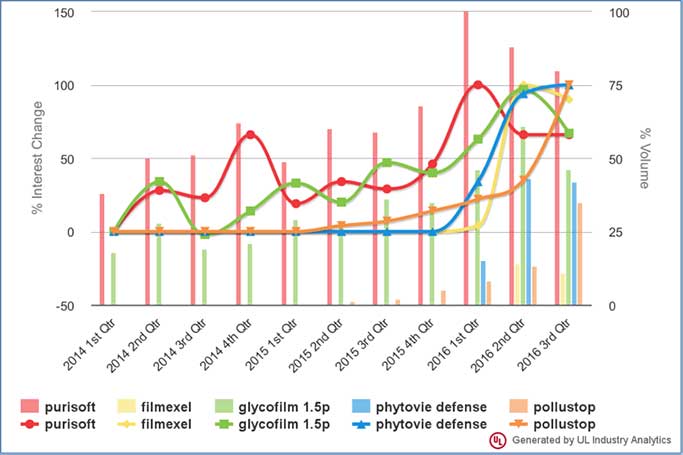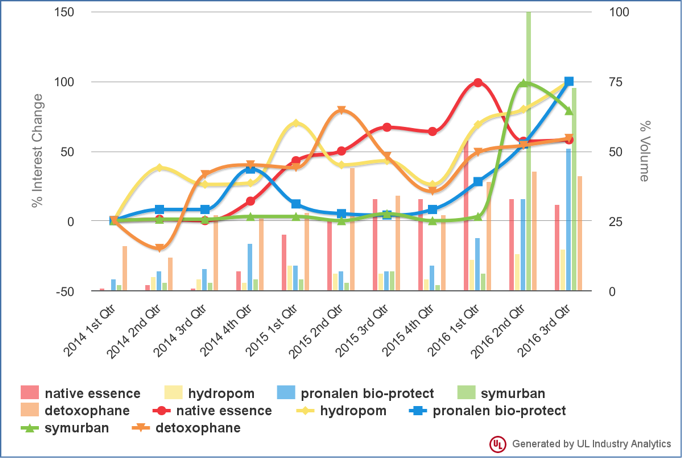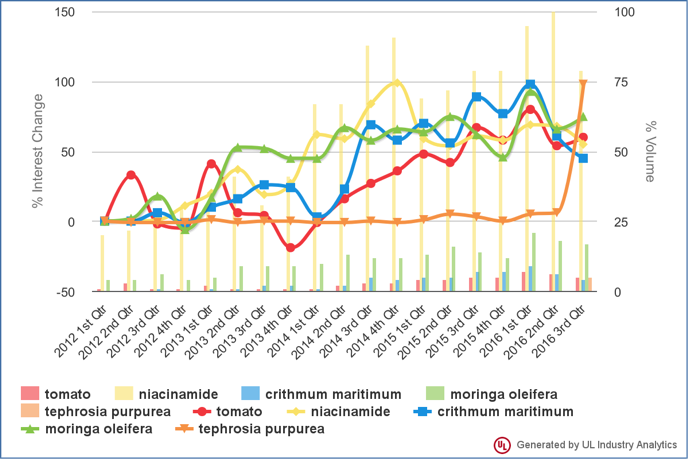
Summary:
Consumers are taking air pollution concerns seriously and looking for cosmetic products that will protect their skin from its harmful effects. Recent research shows that air pollution—including small and fine particulate matter (PM), NO2 and polycyclic aromatic hydrocarbons (PAHs)—is not only deathly damaging to the lungs and heart, but to our skin, too. Premium Beauty News sums up the issue: “Protecting the skin from pollution has become essential, and consumers are expecting specific products to be developed.”
UL’s Industry Analytics is following rises in searches for anti-pollution skincare formulations and ingredients—and a sharp increase for the term “anti-pollution” itself.
Article:
Consumers are taking air pollution concerns seriously and looking for cosmetic products that will protect their skin from its harmful effects.
According to the World Health Organization, more than 80 percent of urban dwellers (in cities that track pollution) are exposed to unsafe levels of air pollution. Recent research shows that air pollution—including small and fine particulate matter (PM), NO2 and polycyclic aromatic hydrocarbons (PAHs)—is not only deathly damaging to the lungs and heart, but to our skin, too.
“Exposure of the skin to air pollutants has been associated with skin aging and inflammatory or allergic skin conditions such as atopic dermatitis, eczema, psoriasis or acne, while skin cancer is among the most serious effects,” write the authors of a University of Athens 2014 review article in Frontiers in Environmental Science.
This February, researchers tied facial age spots to both PMs and NO2 in Asian and Caucasian women. The Guardian interviewed co-author Jean Krutmann, who told the paper that, yes, sun exposure, tobacco use and other environmental factors lead to skin aging, “But what we can say is that, at least for the pigment on the cheeks, it seems air pollution is the major driver.”
As science builds its case, marketers are tracking consumers’ needs for anti-pollution products. Mintel reports that Chinese shoppers are leading the charge, thanks to high levels of air pollution in the country: “The term ‘PM 2.5’ (the abbreviation of Particulate Matter 2.5, which refers to air pollutants with a diameter of 2.5 micrometres or less) has become a marketing claim in Chinese skincare products.”
Western consumers are also feeding demand for protective and healing skin-care products, making this a growing global trend. Premium Beauty News sums up the issue: “Protecting the skin from pollution has become essential, and consumers are expecting specific products to be developed.”
UL’s Industry Analytics is showing parallel rises in searches for anti-pollution skincare formulations and ingredients. And a sharp increase for the term “anti-pollution” itself since 2012.

One class of anti-pollution products create a non-occlusive film to literally block harmful particles from penetrating the skin’s natural barrier. Both BASF’s Purisoft and Solabia’s Glycofilm 1.5P have seen steady search growth over the past two years while newer entries, including TRI-K’s PhytoVie® Defense, Lipotec’s Pollushield™ and Solabia’s Pollustop®, have seen fast interest.

Another category aims to fight pollution damage with anti-oxidants, anti-glycation ingredients and more. Search volume has grown for Mibelle AG’s Detoxophane, Provital’s Pronalen Bio-Protect, TRI-K’s Hydropom and Seppic’s Native Essence. Symrise’s SymUrban® has shown the most dramatic increase in formulator interest in the past two years.

The ingredients that power those anti-pollution compounds are also seeing boosts in their search volume. Long-term search growth is evident for Niacinamide (Vitamin B3), Tomato, Moringa oleifera and Crithmum maritimum (sea fennel). Tephrosia purpurea (wild indigo) has just come on the scene in 2016, but it is showing a big percentage leap in interest. Wild Indigo is the key ingredient in Givaudan’s Neurophroline™, a new stress-fighting extract.

Need anti-pollution ingredients for your cosmetic formulations?
Sign up today for free access to thousands of products in Prospector's materials database. Find technical data, order samples, and more.
The views, opinions and technical analyses presented here are those of the author or advertiser, and are not necessarily those of ULProspector.com or UL Solutions. The appearance of this content in the UL Prospector Knowledge Center does not constitute an endorsement by UL Solutions or its affiliates.
All content is subject to copyright and may not be reproduced without prior authorization from UL Solutions or the content author.
The content has been made available for informational and educational purposes only. While the editors of this site may verify the accuracy of its content from time to time, we assume no responsibility for errors made by the author, editorial staff or any other contributor.
UL Solutions does not make any representations or warranties with respect to the accuracy, applicability, fitness or completeness of the content. UL Solutions does not warrant the performance, effectiveness or applicability of sites listed or linked to in any content.


